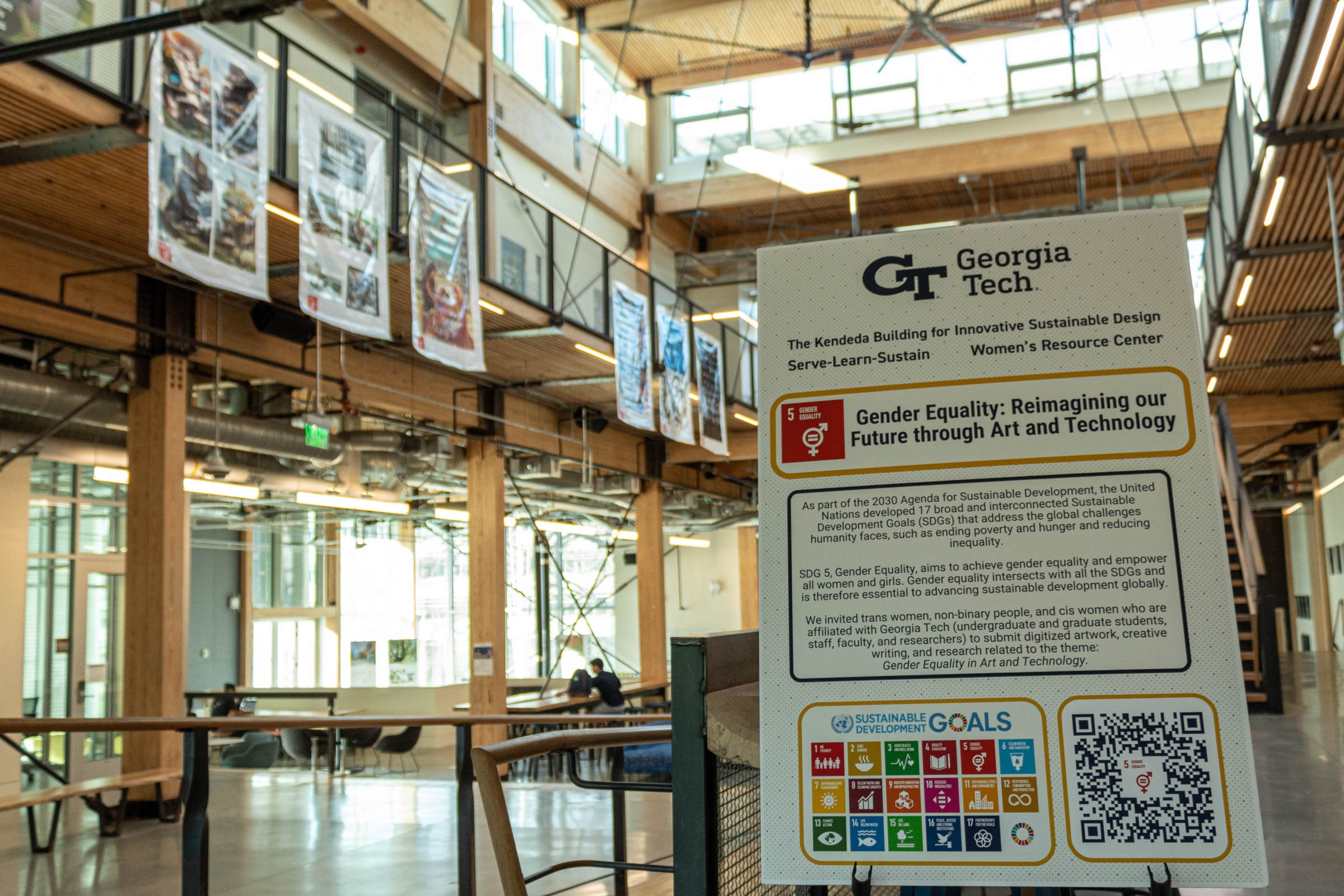
Caption: A view of the Gender Equality Exhibition currently on display at The Kendeda Building, Monday - Friday 7 am - 10 pm.
What is Gender Equality: Reimagining Our Future through Art and Technology?
For the past seven months, I’ve had the privilege of curating and organizing the art and research exhibition, Gender Equality: Reimagining Our Future Through Art and Technology. The process started with a suggestion from my GRA supervisor, Dr. Rebecca Watts Hull, that I combine my Serve-Learn-Sustain (SLS) and master’s project research to coordinate an event around Sustainable Development Goal 5, Gender Equality. This idea blossomed into an exhibition that has far exceeded all my expectations and will remain at The Kendeda Building through December 2022. For folks unable to visit the exhibition in person, you can see all art and research papers by on this digital magazine and on The Kendeda Building’s website.
The exhibition not only showcases women and non-binary folks in technology, but demonstrates how women in technology are reshaping research questions and pushing artistic boundaries that can bring us closer to accomplishing gender equality. This is a unique opportunity for the Georgia Tech community to come together from diverse disciplinary perspectives to be inspired by creative merits occurring on campus to reflect, connect, and reimagine the future of Georgia Tech.
How interdisciplinary passions and research merge
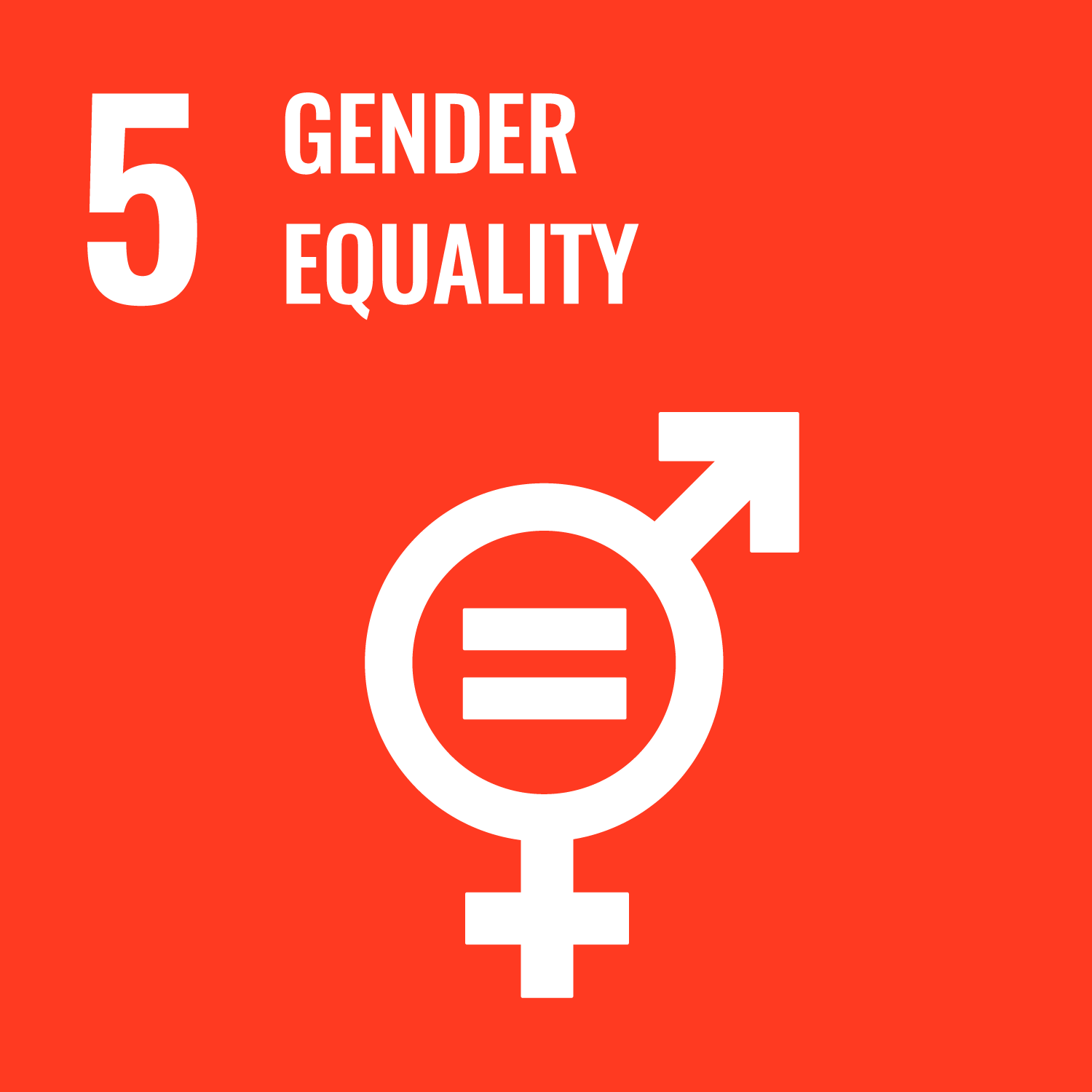 After conducting SDG 5 Gender Equality research to write the Teaching Tool, Teaching Local/Global SDG Connections Through Case Studies, last summer for SLS, I knew I wanted to incorporate that research into my required Digital Media master’s project. When I learned that 2022 marks the 70th anniversary of women allowed to attend Georgia Tech, I thought this would be a great opportunity to weave my passions in gender equality, art, storytelling, and social justice for my master’s project.
After conducting SDG 5 Gender Equality research to write the Teaching Tool, Teaching Local/Global SDG Connections Through Case Studies, last summer for SLS, I knew I wanted to incorporate that research into my required Digital Media master’s project. When I learned that 2022 marks the 70th anniversary of women allowed to attend Georgia Tech, I thought this would be a great opportunity to weave my passions in gender equality, art, storytelling, and social justice for my master’s project.
I designed an interactive oral history exhibition that illuminates women's experiences at Georgia Tech. The aim was to not only celebrate women’s remarkable achievements, but show the reality of attending a male-dominated institution that reinforces how history is neither linear nor fully progressive. By interfacing with objects lined with touch-sensitive conductive tape, snippets of interviews from the Living History Programs are projected. The interview contents vary from feeling the infectious school spirit of Georgia Tech, feeling the hostility from male students and professors, and feeling the need to have two identities in order to survive.
Rebecca believed my master’s project did a great job of bringing the voices of the past to Georgia Tech but suggested how I can involve folks on campus today. After reading Banu Subramaniam’s book, Ghost Stories for Darwin, I was compelled to act upon the quote:
“Feminist efforts for women in the sciences must move beyond just increasing the number of women in science…Instead, a feminist project must include exploring and transforming scientific culture to include not only different bodies but also different visions and cultures, as well as different epistemologies, methodologies, and methods.”
In September 2021, I started to organize an intersectional and feminist art and research exhibition using SDG 5, Gender Equality, as a framework. The goal was to demonstrate how women and gender-nonconforming folks are reshaping research questions and pushing artistic boundaries that can bring us closer to accomplishing this grand goal.
The Exhibition
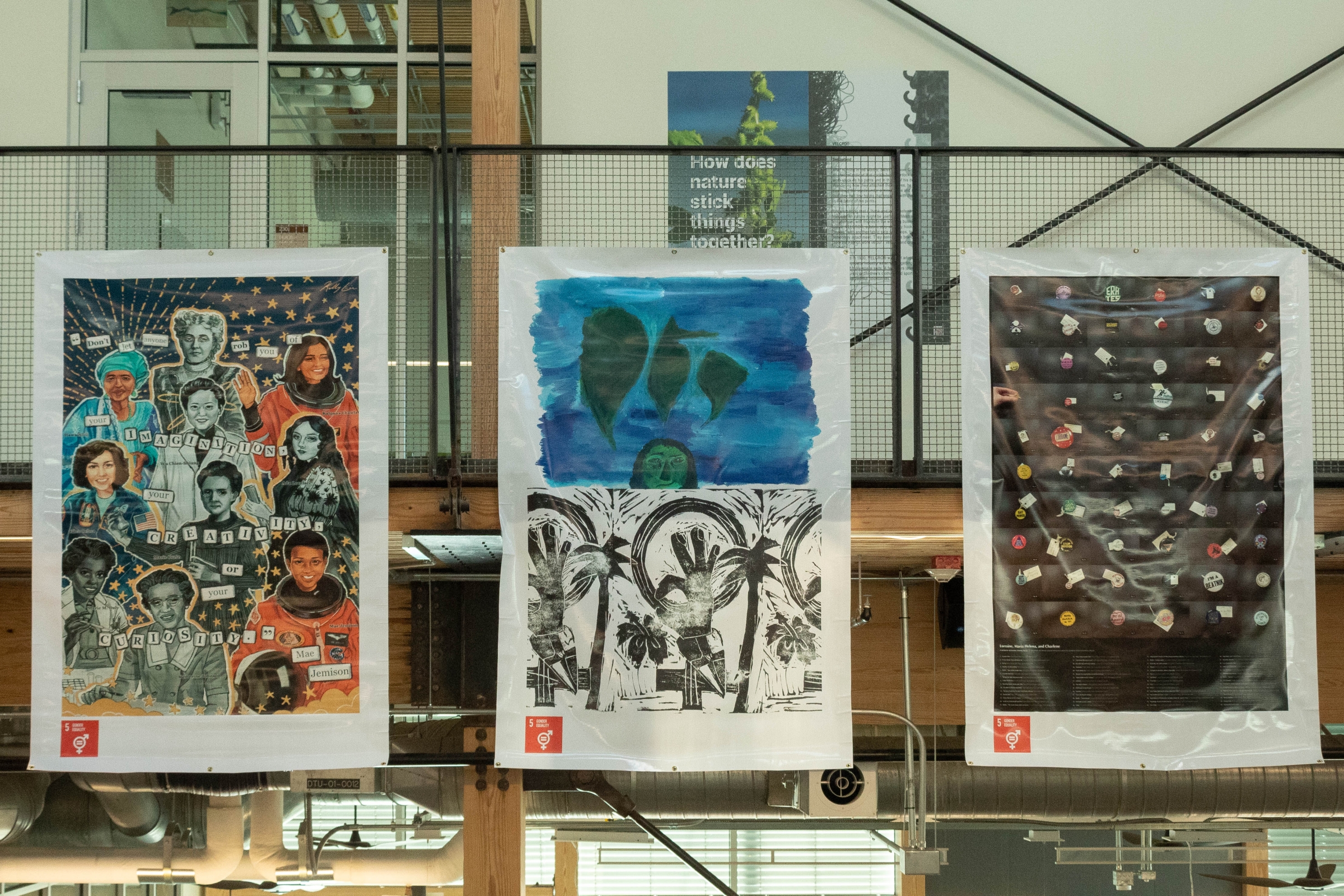
Caption: Banners from left to right: “The Named Pioneers” by Kelly Lin, “Pensamientos Isleños, and Tropical Feminism” by Alexandra Rodriguez Dalmau, and “Lorraine, Maria Helena, and Charlene” by Alexandra Teixeira Riggs hanging from the second-floor of The Kendeda Building.
Trans women, non-binary people, and cis women who are undergraduate or graduate students, staff, faculty, and/or researchers at Georgia Tech were invited to submit digitized photography, artwork, creative writing, and research papers. All submissions were required to incorporate the theme of Gender Equality using the UN’s definition and targets as a reference in relation to art, science, and technology. The submissions did not have to outright address/answer/solve those target, but could be inspired by challenges women face today. Interdisciplinary, feminist, and intersectional submissions were especially welcome.
Undergraduate students, graduate students, and faculty from across Georgia Tech submitted photography, poetry, original illustrations, and research papers that are currently on display:
- Katherine E. Bennett (PhD student,Digital Media & Black Media Studies), Letters & Editors
- Dr. Anne Sullivan (Associate Professor, Digital Media), Gender Representation in the Post-Anthropocene World
- Kelly Lin, (Undergraduate student, Computational Media)The Named Pioneers
- Alexandra Rodriguez Dalmau (Undergrad, Civil and Environmental Engineering), Nuestra Hermandad: Las primeras nueve mujeres latinas en Georgia Tech, Pensamientos Isleños, and Tropical Feminism
- Shruthi Sundar, (Graduate Student, Computer Science) My Hair Was Never Meant to Be Beautiful
- Sylvia Janicki (PhD student, Digital Media), Heart Sense and A Memorial to Earth
- Purna Pratiti Saha (Undergraduate student, Industrial and Systems Engineering), Feminism in the Womb of Bengal
- Alexandra Teixeira Riggs (PhD student, Digital Media), Lorraine, Maria Helena, and Charlene
- Shubhangi Gupta (PhD student, Digital Media), Rethinking Safe Mobility: The Case of Safetipin in India
- Pooja Casula (PhD student, Digital Media), “We found no violation!” Twitter’s Violent Threats Policy and Toxicity in Online Discourse
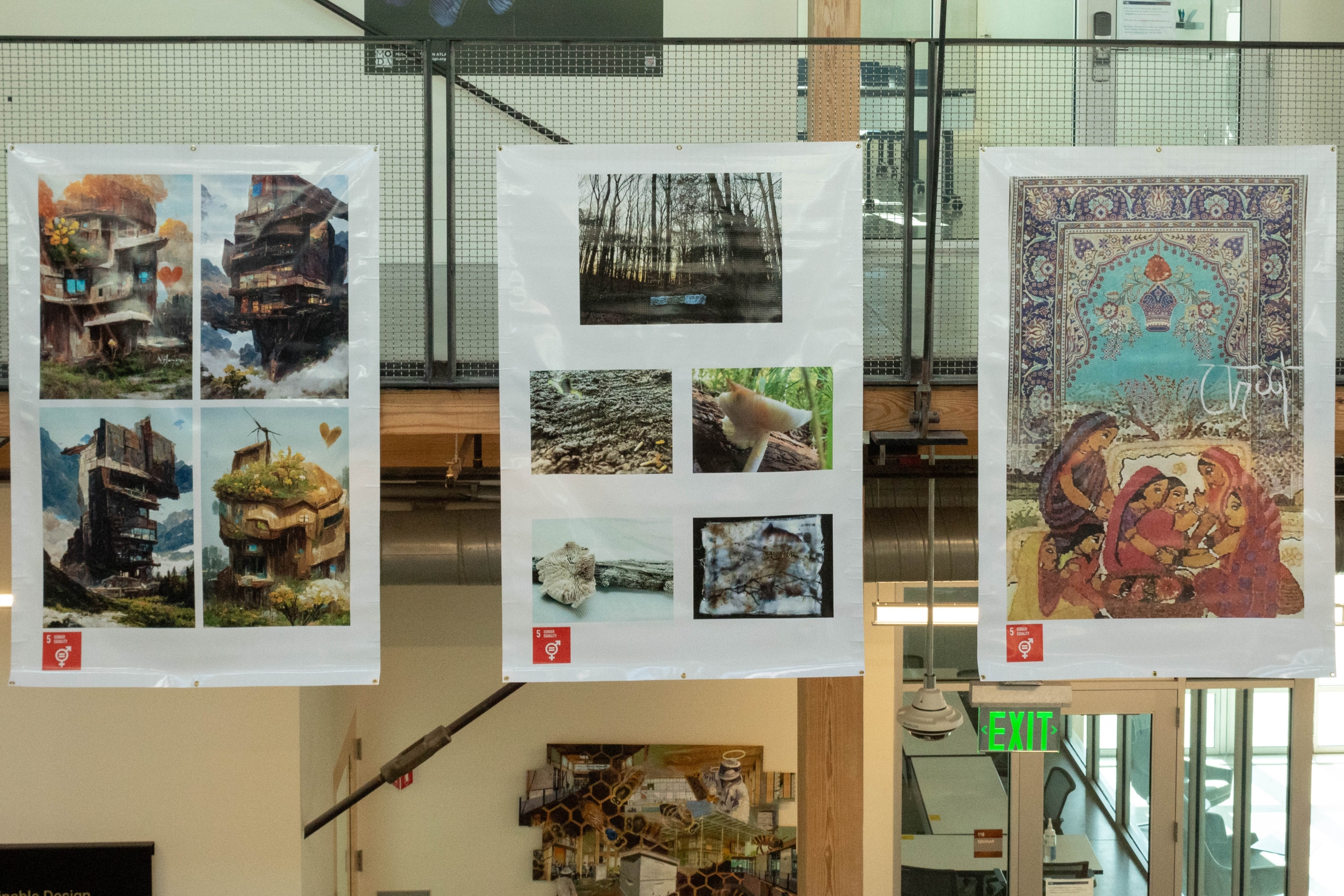
Caption: Banners from left to right: “Gender Representation in the Post-Anthropocene World” by Dr. Anne Sullivan, “Letters & Editors” by Katherine E. Bennett, and “Feminism in the Womb of Bengal” by Purna Pratiti Saha hanging
Hanging from the second floor railing, six 4x6’ banners illuminate the atrium of The Kendeda Building. Across from each banner on centralized ramp are six floor decals with QR codes. The QR codes lead visitors to the digital magazine that holds the artist’s biography and abstract of their artwork. Adjacent to the staircase are three foam board posters.
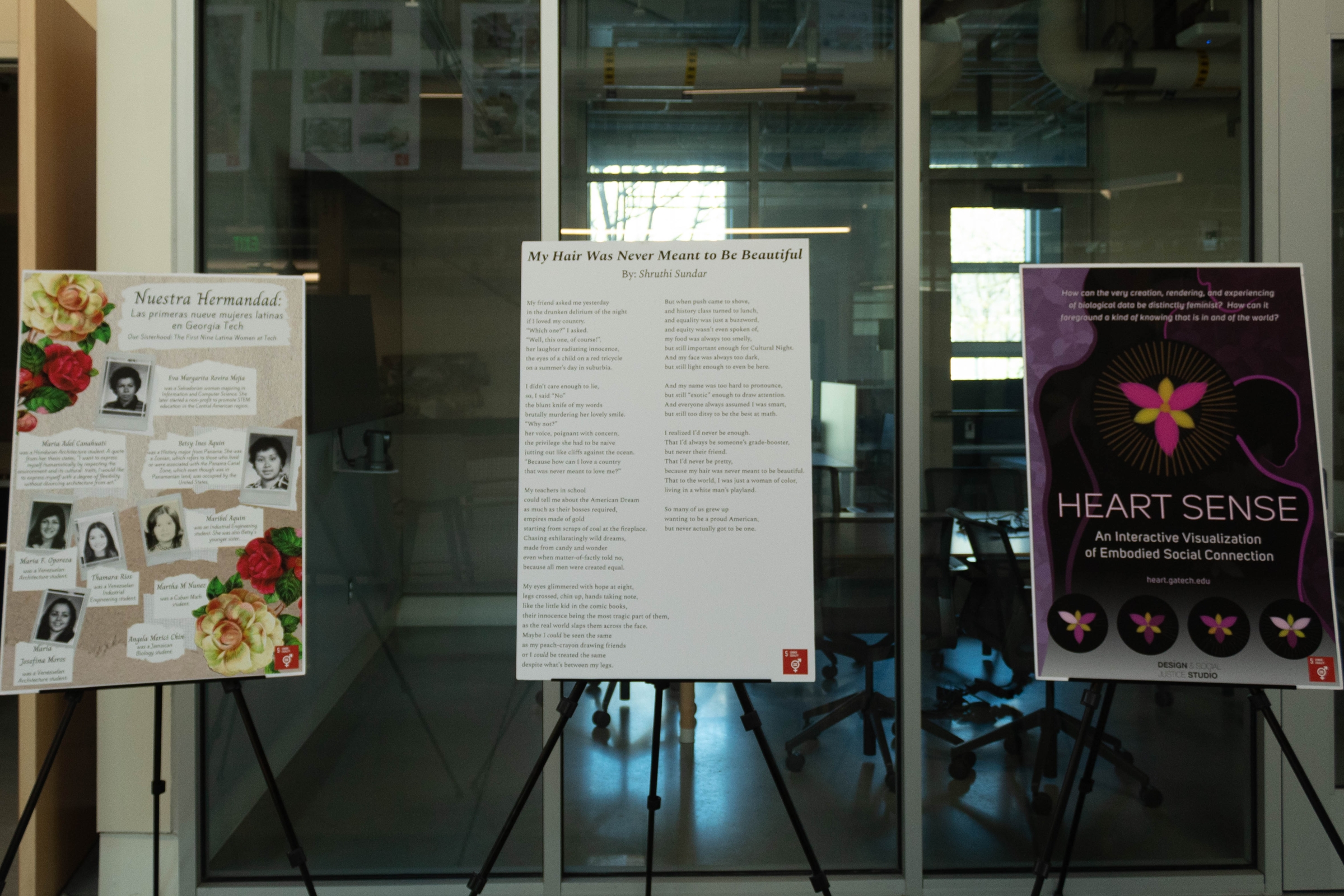 Caption: Posters from left to right: “Nuestra Hermandad: Las primeras nueve mujeres latinas en Georgia Tech ” by Alexandra Rodriguez Dalmau, “My Hair Was Never Meant to Be Beautiful” by Shruthi Sundar, and “Heart Sense” by Sylvia Janicki.
Caption: Posters from left to right: “Nuestra Hermandad: Las primeras nueve mujeres latinas en Georgia Tech ” by Alexandra Rodriguez Dalmau, “My Hair Was Never Meant to Be Beautiful” by Shruthi Sundar, and “Heart Sense” by Sylvia Janicki.
Final Reflections
It was such an honor to curate, organize and display such remarkable works of art. I feel incredibly lucky that these amazing researchers and creators trusted me to share their work with the Georgia Tech community. I asked a two artists to speak more about their experience creating and submitting work to this installation.
I asked Alexandra Rodriguez Dalmau and Katherine Bennett, “What does your submission mean to you? In what way does it feel significant and/or personal?”
Alexandra Rodriguez Dalmau:
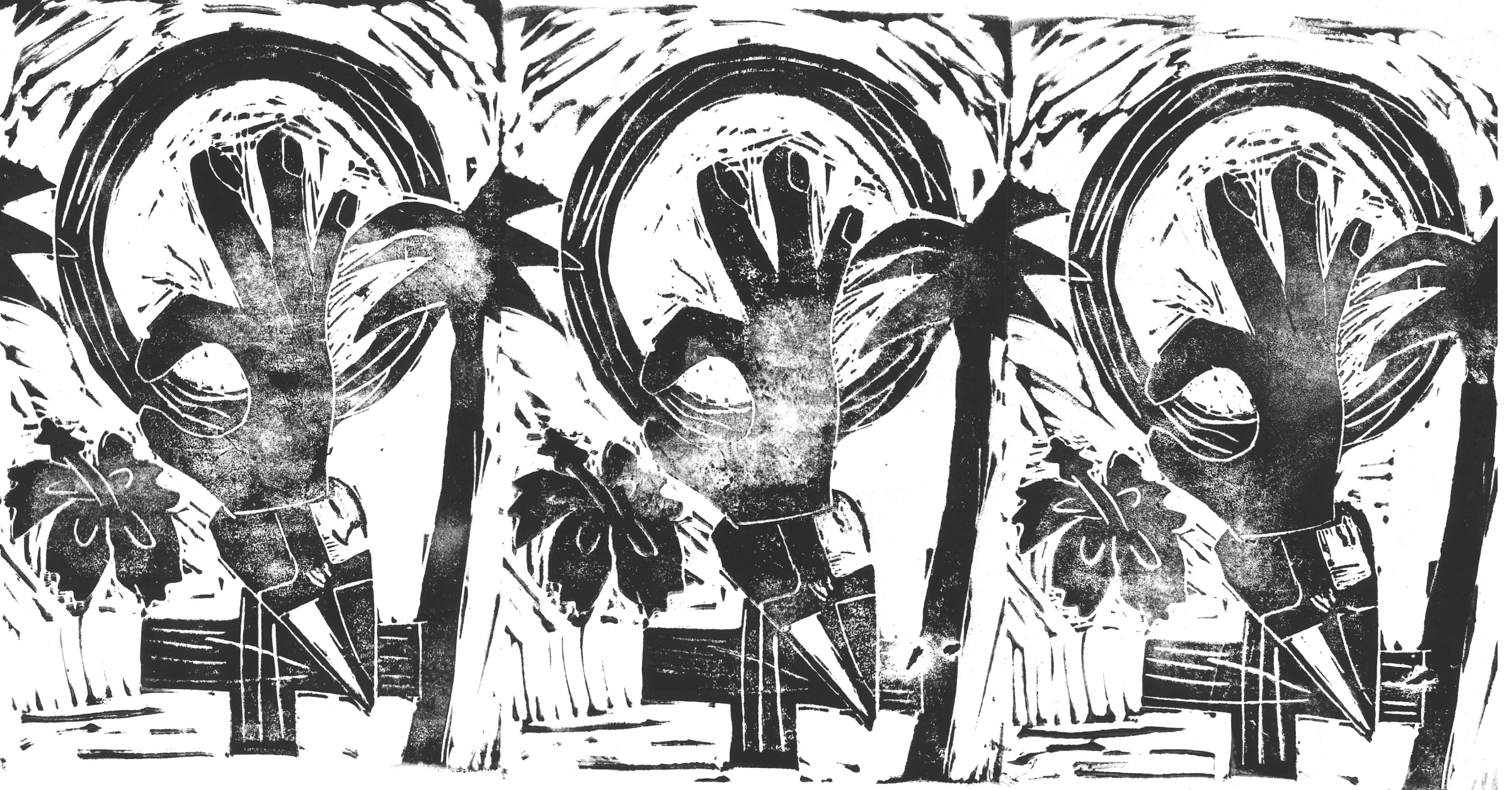
Caption: “Tropical Feminism” by Alexandra Rodriguez Dalmau is a block print art piece that represents Dominican feminists ongoing fight to include the “3 causales” or three circumstances in which they believe abortion should be decriminalized.
“I believe that since girls and women are often the most affected by the world’s pressing problems, particularly those related to poverty and climate change, it seems only natural to me that incorporating them into the design of their solutions would yield better results. As I’m doing research about my country, I can’t help but feel overwhelmed, powerless to the imminent threat of climate change. I wish to learn more about informality, politics, and climate change in the DR, and continue to make art about it.
This exhibition allowed me to showcase multiple submissions which share important stories. Stories that are usually overlooked, and forgotten. I was able to share my country’s situation as well as the names of important women at GT. Friends and strangers have reached out to tell me how much these pieces mean to them. ”
Katherine E. Bennett:

Caption: This quote is from an Atlanta Constitution editorial written in 1944 by Ralph McGill
“Ralph McGill later won a Pulitzer for supporting and reporting on school integration. The editorial extracts text and a message of questionable environmental humanism from his letter correspondence with my grandfather, a tree farmer in rural Georgia whose letters to the editor represented land as numbers and people as races and genders.
I rewrote McGill’s extracts in cotton and rayon, materials that once were extracted from plantations on this land. I buried the extracts in this land for another round of editing by the communicative underground networks of tree roots, mushrooms, squirrels, seedlings, worms, and other forest occupants I can’t see but whose presence is tangible, like changing but persistent representations of race, gender, and place that keep extracting identities for numbers."
Acknowledgements and support
The exhibition is supported by The Center for Serve-Learn-Sustain (SLS), Women’s Resource Center (WRC), and The Kendeda Building For Innovative Sustainable Living (The Kendeda Building).
I’d like to give a special thanks to Shan Aurora, Kamilah Roberts, Rebecca Watts Hull, Kris Chatfield, Melanie DeMaeyer, Anne Sullivan, and Noura Howell for the unwavering support of bringing this idea to life. I’d also like to thank each of the artists again for trusting my vision and providing such great work to Georgia Tech’s community.
